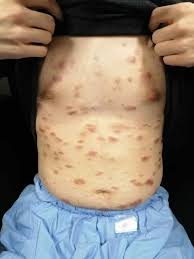 Most common neoplasm seen in the AIDS population with a substantial decrease in incidence since the advent of highly active antiretroviral therapy.
Most common neoplasm seen in the AIDS population with a substantial decrease in incidence since the advent of highly active antiretroviral therapy.
Multicentric angioproliferative disorder that frequently involves the skin.
Incidence among recipients of solid organ transplant 500 times the rate of the general population.
20,000 times more common in patients with AIDS than the rate in general population.
Among patients with HIV, KS is characterized by painless violaceous macules nodules on the feet, legs, trunk, or face.
Kaposi’s sarcoma is the most common cancer, occurring in 10% to 20% of people with HIV.
Human herpesvirus 8 etiologically linked to KS.
Herpesvirus 8 is a gammavirus that contains genes with angiogenic activity.
Kaposi sarcoma associated herpes virus, herpesvirus, 8, is primarily transmitted through saliva that can be acquired through receptive anal, sex, and rarely through organ transplant or blood transfusion.
HHV-8 is known to be transmitted sexually but is also believed to be transmitted from mother to child and potentially among siblings through excretion in saliva.
Seroprevalence varies worldwide with more than 90% in Africa, 20 to 30% in the Mediterranean area, and less than 10% in the US, northern Europe, and Asia.
As a disease advances, spread to region lymph nodes may result in profound lymphedema of dependent areas.
It can progress with disseminated involvement of the oropharynx, lungs, gastrointestinal tract, genitals, or visceral organs.
Pulmonary involvement may result in hemoptysis and gastrointestinal involvement may cause gastrointestinal bleeding, including hematemesis.
After initial infection, the Kaposi sarcoma associated herpes virus exists in the latent state, primarily in B lymphocytes and monocytes.
Viral reactivation associated with oncoenesis can be precipitated by the presence of HIV or malaria, and by immunosuppression.
KS is classified into 4 clinical variants.
lassic Kaposi’s sarcoma affects males without HIV, who are typically older than seventy years,
Endemic Kaposi’s sarcoma occurs in children and adults from endemic areas and affects patients treated with immunosuppressive medications.
Epidemic cases associated with HIV induced immunosuppression.
The skin is the most common site of presentation.
Skin lesions are often solitary, on the soles of the feet.
KS typically has no fever associated with it.
Skin lesions usually have a regular borders.
There may be silent lesions in the gut and lungs, even in the absence of skin lesions.
KS lesions in the mouth, usually appear on the hard or soft palate, on the gums or buccal mucosa.
AIDS-related Kaposi’s sarcoma tends to be multicentric, often involving mucous membranes of the gastrointestinal tract and occurring in atypical locations.
Severe KS may have more diffuse cutaneous manifestations of involvement of mucosa, visceral, organs, and lymph nodes.
KS lesions may accelerate with use of glucocorticoids.
Treatment:
First line treatment of iatrogenic KS is the withdrawal or reduction of immunosuppressive agents, which often results in a partial or complete remission.
Some patients may respond to HAART treatment, particularly those naïve to antiretroviral treatment and with a small tumor burden.
AIDS related aggressive disease generally treated with liposomal anthracyclines plus HAART, with a 70% response rate.
Liposomal anthracycline therapy for AID related aggressive disease not curable with present treatment.
More widely dispersed lesions with frequent lymph node involvement and poorer response to therapy than classic forms.
Radiosensitive tumor with response rates from 80-90% in most lesion types.
A significant percentage of patients with HIV-KS will respond to combination anti-retroviral therapy alone.
The goal of therapy for KS is palliation, and there is no evidence that achieving a complete response is curative.
Radiation therapy generally reserved for patients with limited disease that is causing pain or other symptomatology.
Nivolumab has signficant antitumor activity in HIV-positive Kaposi sarcoma.
((Pomalidomide)) is arrived for the treatment of adults with AIDS-related Kaposi sarcoma that did not respond to highly active antiretroviral therapy and Kaposi sarcoma in adults who are HIV-negative.
